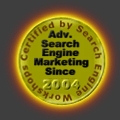 Look how old this is!
Look how old this is! I post at SearchCommander.com now, and this post was published 16 years 8 months 19 days ago. This industry changes FAST, so blindly following the advice here *may not* be a good idea! If you're at all unsure, feel free to hit me up on Twitter and ask.
I’ve been working with a client in a competitive search space for several months now, and we’ve had pretty good success in raising their organic search engine visibility.
When we first began working together, I was told they were already developing a new system that would make management of this multi thousand page site easier, and when the time came, I would be brought in to consult on the project to ensure that the search engine rankings would be retained.
Well yesterday was that day, and I was brought in to their weekly development call that turned into sort of an ugly scene thanks to my tactful personality 😉
Before the meeting I was told that ALL of the URLs were going to change for the entire website, and it was being built with Ruby on Rails, a language which I know nothing about.
This is to be expected when changing from one system to another, and the damaging effect to search visibility of a one-time change of file structure and URLs can be somewhat overcome by using 301 redirects.
This tells the the search engines that a page has permanently moved, and (theoretically) transfers PageRank, inbound link counts, and search rankings to the new URL. While not changing them in the first place is preferable, changing them once may be unavoidable.
I also was told before the call that there was still no working model of this website online. There was nothing for me to see except a 15 page PDF file, that was a graphical representation of what was coming in the site design.
So we began, and as the telephone call went on, we discovered a couple of things this custom system would not do that had the potential to affect search ranking in a huge way.
One was that the images of the “products” themselves, (for which thousands have been taken with a digital camera) could not be linked to directly. In other words, I couldn’t e-mail someone a link and say “look at this picture”.
As Google and the other search engines integrate more media files into the front page of the search results, getting images, audio and video files indexed and ranked is going to become even more important as time goes on.
If you find an image you like, and want to share one of their pictures on Facebook, Myspace or anywhere else… you can’t. If you want to “tag” or bookmark it as you stumble across the image, that’s just something that can’t be done on this site.
Now admittedly, building inbound links to all of their images isn’t that big a deal, but it just seems a shame to have it designed that way and eliminate the possibility.
Note to developers: make sure that anyone can share anything on your website by always making all files and all pages accessible via a permanent link. If your system won’t do that, then fix your system or change to one that will.
As a couple of other limitations were revealed, we were able to offer up logical solutions to counteract any search chilling effects, primarily with static site map pages to different sections of the website.
However, then came what I would categorize as a “deal breaker” for this system if it cannot be repaired: ever-changing URLs.
She said that maintaining static site maps was going to be an enormous task, because the URLs might change when you make changes to the site . What?!
She then went on to say that as content gets added or changed for certain areas of the website, other URLs within that same area may be affected, and the old URLs may “break”.
Needless to say, this didn’t go over well with me, and I made that pretty clear. I’m afraid I don’t remember exactly what I said, but the phrase “worthless piece of crap” may have been used. That’s where things deteriorated, and then she suddenly had to leave.
She claimed she was going to spend time this weekend writing up an explanation of how this website works, and why I didn’t understand. Well, she’s right. I don’t understand…
Here’s another tip for all programmers and web developers of any caliber, any experience level, any ability, and using any programming language from .html, to Ruby on Rails: DON’T CHANGE YOUR URL’s!
As the search engines visit index and your pages, they expect to see those pages the next time they visit too, in the same place, with the same file name.
If you change your URLs, you’re going to end up with 404 errors, which the search engines don’t like.
If you change your URLs you’re going to end up with pages in the search results that when clicked upon, take the user to a “page not found”.
If you change your URL’s your visitors favorites and bookmarks are not going to work any more.
If you change your URLs you’re doing yourself and your visitors a disservice, and you’re making a big mistake for being found in the search engines.
Inbound links are the lifeblood of your search engine visibility. After all of the “search engine friendly” fundamentals are in place, your popularity is going to be determined by the number, quality, and relevance of your inbound links.
Changing those links, for any reason at all, must always be accompanied by a redirect command to the search engines and visitors that the page has permanently moved, so they don’t end up on an error page.
Fortunately, after she left, another programmer on the call explained that he fully understood the need for URLs to remain consistent, and he can’t imagine why any of the primary existing URLs would have to change. He was going to be in communication with her to see if something can be worked out. Let’s hope so…
When I wrote How to Build a Crappy Content Management System it never even crossed my mind that someone might do this, or that would have been number one on my list!




















Thank you for your posting, Scott.
I can certainly sympathize with your situation. I know of no other situation for an Internet consultant that is more frustrating. They want these terrific results, but they also want to inject their two cents worth whenever they can, so, they can feel like they’re getting their money’s worth. This leads to both delays in the tasks, and a constant battle between the consultant and the developer as they get to collectively determine which is most important.
My ideal, dream client is one that will do what I say, when I say, without question. The statement “you’re the expert†is one that I like hearing what I’m dealing with a client. I certainly don’t mind justifying my actions with a few phrases to help explain the procedure. But, when it becomes a focal point for debate, then I start wondering if I’ve charged enough for this client.
To give you an example of a client that does all the right things, my latest client, an online Sports Nutrition company came to me about four months ago with a brand new website trying to optimize for an extremely competitive search phrase, nutritional supplements, sports nutrition, and discount supplements.
But, here’s the kicker. This client did exactly what I said, when I said to do it, in the manner in which I said to do it. They also dedicated the appropriate budget for marketing and new link development. After only three months, this site also ranks Top 10 for “bodybuilding supplies†for my SEO Longtail strategy and we are and climbing quickly in Google for the extremely competitive keywords. Further, we also targeted the top 100 selling products and decided that we want to develop special organic pages just for these products. Additionally, we did an entire 301 redirect and URL taxonomy change successfully for almost 3000 products.
Now mind you, this is a three month campaign. I say all of this because this was all due to a client that respected my expertise and did what I said. This client went from zero to 100 unique visitors per day from a variety of sources in three months. I can’t imagine how this would have turned out if we got delayed our first month are shopping cart issue. We got a lot done in three months.
I write this because you and I are peers in this field and you come across a situation that seems more of the norm than the exception. Knowledge: it’s a dangerous thing.
“Do not ask why. Only do.â€
Customers. What can you do?
I think its crazy to chnage URLs. Its like starting from scratch. We had no choice but to do it for a client because of teh pay the site was set up. It was a mess. But we are still waiting for Google to spider it correctly!